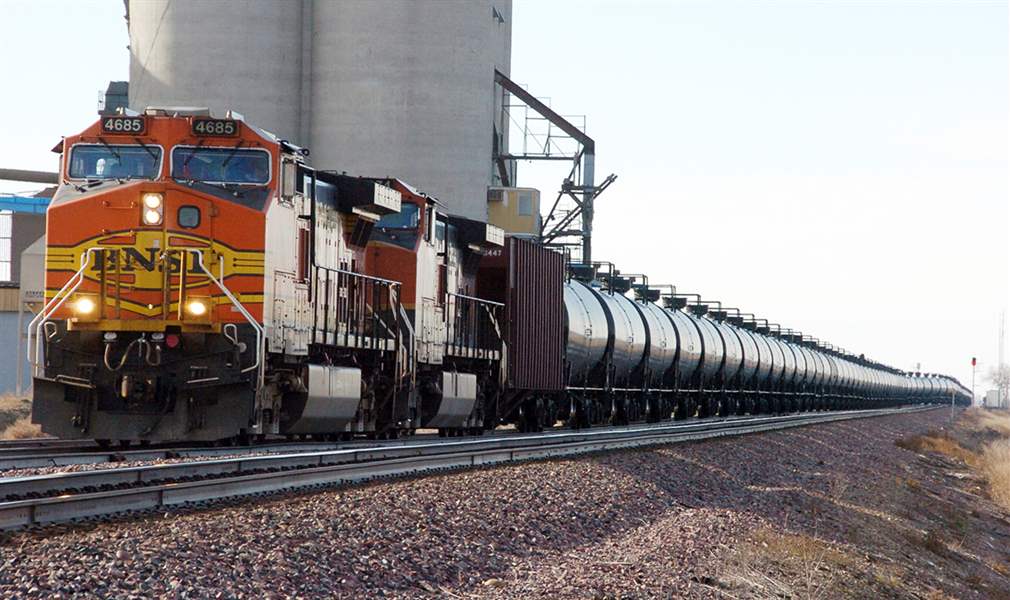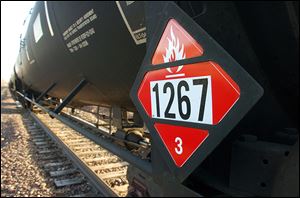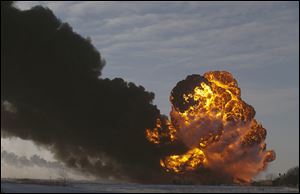
OIL BONANZA POSES TRANSPORTATION DANGER
Railroads look to minimize risk of explosive train wrecks
Train accidents stir safety worries as oil boom sends more tanker trains across North America
2/17/2014
A BNSF Railway train hauls crude oil near Wolf Point, Mont. With potentially explosive shipments increasing 40-fold as crude production booms, the railroad industry, at the urging of the Obama Administration and U.S. and Canadian safety officials, is considering a closer look at industry risks.
ASSOCIATED PRESS

A BNSF Railway train hauls crude oil near Wolf Point, Mont. With potentially explosive shipments increasing 40-fold as crude production booms, the railroad industry, at the urging of the Obama Administration and U.S. and Canadian safety officials, is considering a closer look at industry risks.
BILLINGS, Mont. — At least 10 times since 2008, freight trains hauling oil across North America have derailed and spilled significant quantities of crude, with most of the accidents touching off fires or catastrophic explosions.
The derailments released almost 3 million gallons of oil, nearly twice as much as the largest pipeline spill in the United States since at least 1986. And the deadliest wreck killed 47 people last year in the town of Lac-Megantic, Quebec.
Those findings, from an Associated Press review of U.S. and Canadian accident records, underscore a lesser-known danger of America’s oil boom, which is changing the global energy balance and raising urgent safety questions.
Experts say recent efforts to improve the safety of oil shipments belie an unsettling fact: With increasing volumes of crude moving by rail, it’s become impossible to send oil-hauling trains to refineries without passing major population centers, where more lives and property are at risk.
Adding to the danger is the high volatility of the light, sweet crude from the fast-growing Bakken oil patch in Montana and North Dakota, where many of the trains originate. Because it has more natural gas than heavier crude, Bakken oil can have a lower ignition point. Of the six oil trains that derailed and caught fire since 2008, four were from the Bakken, and each caused at least one blast. That includes the accident at Lac-Megantic, which spilled an estimated 1.6 million gallons and set off a blast that leveled a large section of the town.

A warning placard appears on a tank car carrying crude oil near a terminal in Trenton, N.D. Experts say it’s become impossible to send oil-hauling trains without passing major population centers.
After recent fiery derailments in Quebec, Alabama, North Dakota, and New Brunswick, companies and regulators in the United States and Canada are pursuing an array of potential changes, such as slowing or rerouting trains, upgrading rupture-prone tank cars, and bolstering fire departments. Company executives were expected to offer a set of voluntary safety measures soon at the request of U.S. Transportation Secretary Anthony Foxx.
“I’m absolutely positive the railway industry will come up with techniques to define how to minimize risk,” said Allan Zarembski who leads the rail-safety program at the University of Delaware. “The key word is ‘minimize.’ You can’t eliminate risk.”
Since 2008, the number of tanker cars hauling oil has risen 40-fold, and federal records show that’s been accompanied by a dramatic spike in accidental crude releases from tank cars. In the next decade, rail-based oil shipments are forecast to increase from 1 million barrels a day to more than 4.5 million barrels a day, transportation officials say.
By rail, it’s roughly 2,000 miles from the heart of the oil boom on the Northern Plains to some of the East Coast refineries that turn the crude into gasoline. Trains pulling several million gallons apiece must pass through metropolitan areas that include Minneapolis, Chicago, Cleveland, and Buffalo.
Some cities such as Chicago have belt railroads that divert freight traffic from the metropolitan core. But elsewhere, railroad representatives said, the best-maintained and safest track often runs directly through communities that were built around the railroad.
Experts say the explosive nature of Bakken oil derailments caught everyone off guard — from regulators to the railroads themselves.

A fireball rises at the site of a derailment in Casselton, N.D. Experts said no one expected the explosive nature of the light, sweet crude from the Bakken oil field.
“I don’t think people understood the potential for a problem if there were a derailment,” said Jason Kuehn, a railroad executive who is now vice president for Oliver Wyman, an industry consulting firm.